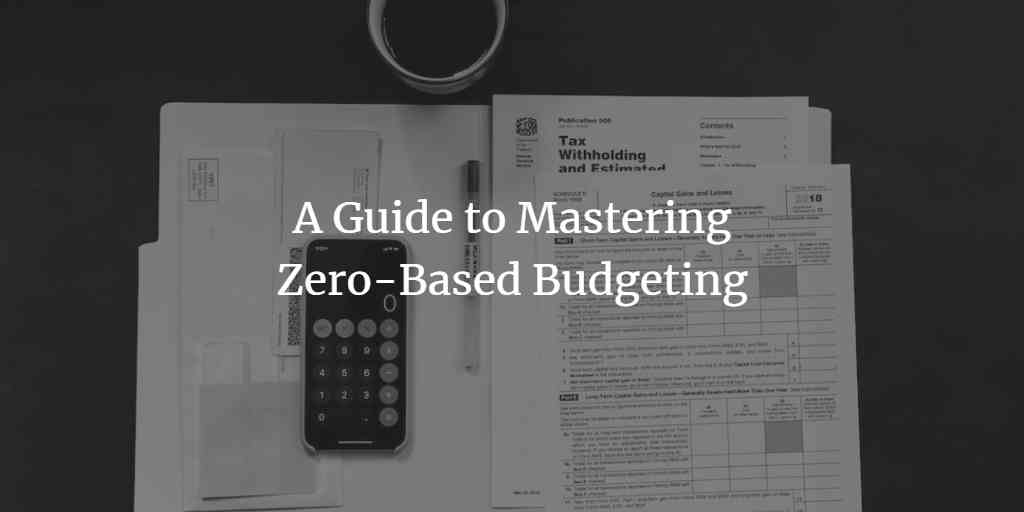You all know that putting your money to work is the best way to maximize the gain as well as to attain financial freedom. The more money working for you, the nearer you are to attaining financial freedom as well as maximizing your financial potential. Now just allocating the money to work for you by putting into the investment is one thing and making goals out of that investment is other. The zero-Based Budgeting Technique helps in making goals for that investment better because you are giving the money a job to do as well as analyzing it.
What is the Zero-Based Budgeting Technique?
Zero-Based budgeting or Zero-Sum budgeting is an approach where all your monthly money (expenses, savings, investments) is justified or should be categorized. In this way, you will know where your income has gone.
It is different from other budgeting techniques is that in this type of budget you start with zero after every time period (most probably a month). So any leftover or extra funds from the previous period should be moved to savings or debt repayment.
In simple terms, zero-based budgeting is a technique where your income minus expenditure should be zero at the end of the month. For example, if your income is 100$ and your expense is 75$ then you will move that 25$ to savings or debt repayment and will start with Zero-Sum from the next month onwards.
This budgeting approach is more time-consuming and resource-intensive than traditional budgeting methods, but it can help individuals to know where to put their money at the end of the month so that they can easily complete their financial goals and be on top of it.
The best way to create a Zero-based budget
To create a Zero-Based Budget, first, you need to identify all your monthly expenses and then you need to assign categories to those expenses. The categories can be housing, transportation, debt repayment, groceries, entertainment, savings etc. Along with that, you can also create a sub category of your investments (the financial goals) like buying a car, vacation, or retirement.
Once the categories are created, it’s time to determine how much you will be spending in each category. Now to get to the real figure we need to analyze the last month’s expenses and then accordingly tweak for the next month. In this way, you are actually limiting yourself to keep your expenses lower than your income and thus also contributing towards your financial goals.
If your expenses are exceeding than your income then you have to revise your budget and remove some of the expenses from the current period budget or you have to increase your income. The goal here is to keep your expenses lower than your income.
If your expenses are lower than your income then you need to assign the leftover money to some categories most important to your financial goals. This is how you will be creating a zero-sum budget.
Now every month you need to adjust your budget based on the data of previous months or based on any unexpected expense that comes your way.
The general steps to creating a zero-based budget are:
-
Identify your goals for the month: At first, you need to identify the goals for the current month because it will help you to determine the money needed to achieve those goals.
-
Determine the money needed: Then we need to determine how much money is needed to complete that goal.
-
Identify all expenses: Then we need to create a list of all expenses.
-
Analyze and justify each expense: Then we need to analyze all the expense and categorize it.
-
Allocate resources: And then based on the analysis done, we need to allocate the money to the expenses or financial goals.
-
Continuously monitor and adjust the budget: Once the budget is created, it’s important to continuously monitor and adjust it as needed to ensure that you stay on track to achieve the goals and objectives.
It’s worth mentioning that the Zero-based budgeting process is more time-consuming and resource-intensive than traditional budgeting methods, but it can help individuals make more informed decisions about where to allocate money and ensure that all expenses are aligned with the individual’s goals and objectives.
How Zero-Based Budgeting method is compared to Other budgeting methods?
Zero-based budgeting is different from traditional budgeting methods in several ways:
-
Starting point: Other budgeting methods start with previous period’s budget as a starting point, whereas zero-based budgeting starts from a “zero base” and every expense must be categorized.
-
Focus: Traditional budgeting methods focus on adjusting the last month’s budget, while zero-based budgeting focuses on identifying the individual’s current goals and objectives and adjusting current month’s budget.
-
Flexibility: Traditional budgeting methods are often inflexible and can be difficult to adjust, while zero-based budgeting allows for greater flexibility and adaptability.
-
Accountability: Traditional budgeting methods can lead to a lack of accountability, as expenses are often automatically carried over from previous periods, while zero-based budgeting promotes accountability by requiring all expenses to be categorized.
Overall, Zero-based budgeting is a more comprehensive and strategic approach to budgeting but it requires more time and resources than traditional budgeting methods, but it can help individuals make more informed decisions about where to allocate money and ensure that all expenses are aligned with the individual’s financial goals.
How to Track Your Progress With Zero-Based Budgeting
Tracking progress with zero-based budgeting involves regularly comparing actual results to budgeted amounts and making adjustments as needed. Here are some steps to help track progress:
-
Set clear budget targets: Identify specific budget targets for each category of expenses. It will be based on last month’s data.
-
Monitor actual results: Regularly monitor actual results by comparing them to budgeted amounts. This can be done using budgeting software, spreadsheets, or other tools.
-
Analyze variances: Analyze any variances between actual results and budgeted amounts to understand the reasons behind them. This can help to identify areas where the budget may need to be adjusted in the next period.
-
Make adjustments: Make adjustments to the budget as needed, based on the analysis of variances.
-
Continuously review: Continuously review the budget and actual results to ensure that you stay on track to achieve your goals. This is teh most important step.
It’s important to note that tracking progress with zero-based budgeting requires continuous monitoring and adjustments.
Zero-based budgeting advantages and disadvantages for personal finance
Here are some advantages and disadvantages of using zero-based budgeting for personal finance:
Advantages:
-
Greater control over finances: Zero-based budgeting gives you greater control over your finances by requiring you to justify all expenses and allocate your money in a way that aligns with your goals and objectives.
-
Increased savings: By analyzing and justifying all expenses, zero-based budgeting can help you identify areas where you may be able to reduce or eliminate unnecessary expenses, leading to increased savings.
-
Improved financial decision-making: Zero-based budgeting provides a more detailed and accurate picture of your expenses, allowing you to make more informed decisions about where to allocate your money.
-
Greater accountability: Zero-based budgeting promotes accountability by requiring you to justify all expenses and make conscious decisions about where to allocate your money.
Disadvantages:
-
Time-consuming: Zero-based budgeting can be a time-consuming process, as it requires you to analyze and justify all expenses.
-
Requires commitment: Zero-based budgeting requires a commitment to change and continuous improvement, and it’s not a one-time process.
-
May require additional resources: Zero-based budgeting may require additional resources such as budgeting software or tools.
-
Can be difficult to adjust: Zero-based budgeting can be difficult to adjust, especially when unexpected expenses arise or your financial situation changes.
FAQs About Using the Zero-Based Budgeting Rule in Personal Finance
Here are some frequently asked questions about using the zero-based budgeting rule in personal finance:
Q: Can I use zero-based budgeting for my personal finances?
A: Yes, you can use zero-based budgeting for your personal finances. The same principles of analyzing and justifying all expenses apply, regardless of whether you are creating a budget for a business or for your personal finances.
Q: How is zero-based budgeting different from traditional budgeting methods for personal finance?
A: Zero-based budgeting is different from traditional budgeting methods for personal finance in that it starts from a “zero base” and every expense must be justified. Traditional budgeting methods for personal finance often involve creating a budget based on last month’s or last year’s spending.
Q: How can I create a zero-based budget for my personal finances?
A: You can create a zero-based budget for your personal finances by identifying your goals and objectives, determining your income and expenses, analyzing and justifying each expense, allocating your money to the most important expenses, and continuously monitoring and adjusting your budget as needed.
Q: How can I track my progress with zero-based budgeting for my personal finances?
A: You can track your progress with zero-based budgeting for your personal finances by regularly comparing your actual expenses to your budgeted amounts, analyzing any variances, making adjustments as needed, and communicating your progress to yourself or someone you trust.
Q: What are the benefits of using zero-based budgeting for personal finance?
A: Zero-based budgeting for personal finance can help you make more informed decisions about where to allocate your money, ensure that all expenses are aligned with your goals and objectives, and promote greater accountability and control over your finances. It can also help you to better understand where your money is going and identify areas where you may be able to save money.
Overall, zero-based budgeting can be a powerful tool for personal finance management, but it requires commitment, time and resources. It’s important to weigh the pros and cons and decide if it’s the right approach for you.
 Gopesh Sharma
Gopesh Sharma 
 Manage Your Money With the 50/30/20 Rule of Budgeting
Manage Your Money With the 50/30/20 Rule of Budgeting